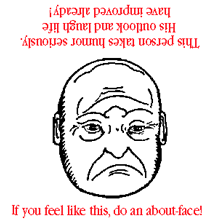Addressing a student's aberrant behavior in a humorous manner is a great way to send a "cease and desist" message without bringing about defiance or hurt feelings. "Cute" joking can serve as a first "reminder" to engage in an appropriate behavior, or halt an inappropriate one. The use of wit exudes a confident understated guidance while symbolically setting limits.
There are two really important things that you should always remember. I forgot the first one. But anyway, the second one is: In order to be effective AND still allow the youngster to save face when complying, it is important that the humor be good-natured and non-sarcastic. Hurtful humor has no place in the school house. Turn a frown upside-down.
Turn a frown upside-down.
Keep in mind that we wish to gain compliance and communication, not dominance. We want to connect personally with our students, not detach them from us emotionally. Humor (the kind, witty, helpful type) builds interpersonal bridges
.
Hurtful commentary destroys them.
Below, you will find some examples (from the assignments of my graduate students) of the humor I speak of. Go beyond the smile these bring to your lips. Analyze the wit, the thought, the guidance, and structure of the humorous comments so that you can start to employ this technique.
EXAMPLES
*A class is walking noisily through the hallway. The teacher gives a surprised look and says "I must have picked up the wrong class from lunch. My students know how to walk through the hallways quietly." The youngsters smile and return to their usual quiet behavior.
*Joseph is running around the classroom with his arms held outward, making airplane noises. The teacher says "Please land that plane on the runway by Joseph's desk and pull it into the desk hanger." With a crashing sound, he plops into his seat and takes out his work. The appreciative teacher says "Thank you. Please remember that our classroom is a 'no fly' zone."
*A student is taking an unusually long time at the drinking fountain. The teacher says "Let's go Anne. If you drink any more, you'll float down the hallway." The student smiles, takes one more sip, and walks back to the room.
*Two students are still talking after other students have become attentive to the lesson. The teacher says "Did you two eat parrot for lunch? Let's close those beaks." They smile and become attentive.
*Unlike others in the class, Sammy has ignored the teacher's direction to turn his already open book to page 32. The teacher walks over to his desk and starts pulling at the page of the book, pretending that it is stuck. Finally the teacher, using both arms, pulls it up and over with a tremendous struggle and says "Whew. I think that the pages should turn easily from now on. I'm sure that you won't be needing my assistance again."
*Mike comes to class without a pencil, and despite being handed an assignment, does not ask to borrow a pencil. The teacher says "Mike, do you need to sharpen that finger? It looks kind of dull." Mike laughs and asks to borrow a pencil.
When Calibe yells out an answer, the teacher says "Calibe, you must be called upon to give an answer. Now you don't have to raise your hand, but you must raise your elbow."
Your turn:
Below are some common classroom situations. Think of a humorous response. It may take a while and you may want to brainstorm with a group of colleagues. Don't worry. Once you get the idea, witty comments will come more quickly to mind when faced with unsuitable behavior.
1. A student comes back after a long time at the bathroom.
| After you've thought about it, click here for some other possibilities. |
2. Students are talking at beginning of class when bell signals time to listen.
| After some thought, click here for another possibility. |
3. A student curses at someone.
| After thinking about it for awhile, click here for some other possibilities. |
4. A student is making animal noises in the back of the room.
| Click here to see other answers. |
![]()
| Fetch Dr. Mac's Home Page |
Author: Tom McIntyre at www.BehaviorAdvisor.com